Author: erkan

Kutahya Museum and Malatya Museum
Kutahya Museum and Malatya Museum,
KUTAHYA MUSEUM
After Iznik Kutahya is the most important porcelain center of Turkey. The first museum here began as a depot in the Vahit Pasha Library in 1945 and contained archaeological and ethnographical objects collected from the region of Kutahya. After 1960 the Vacidiye Medrese, which was built in 1314 during the Germiyanoglu period in Kutahya, was repaired and the works from the depot exhibited here. It was opened to the public in 1965.
The portal of the Vacidiye Medrese leads first into a domed vestibule and from here to the courtyard. The courtyard was enclosed with a dome during the latest repairs, and in the center is a small pool, opposite which is an arched exedra. The sarcophagus of Abdulvacid, a teacher at the Medrese, is in the exedra. On both sides of the exedra and courtyard are the domed rooms which used to house the students.
Kutahya Museum contains archaeological findings, ethnographic objects and works of art from the region of Kutahya. The archaeological works are divided into two sections : One containing works from the Hellenistic, Roman and Byzantine periods such as statues, gravestones and capitals of columns, while the other section contains stone tools and pottery from the Prehistoric Age, Hittite, and Phrygian pottery, and ceramics, lamps, small statues and coins from the Roman-Byzantine period.
In the art and ethnographic section are examples of porcelain from Kutahya and the rest of Turkey, reproductions of wall tile decorations, and costumes, embroidery, tekke objects, weapons, copper utensils, ornaments, books etc. from Kutahya.
Pre-Islamic and Islamic period stone works are exhibited in the courtyard of the museum.
MALATYA MUSEUM
In 1969 a museum was established in the National Park in Malatya which was opened to the public in 1971. The museum contains the following exhibits arranged in chronological order:
1 — Chalcolithic Age (5000-3000 BC): Clay pots and instruments made of stone and obsidian found during excavations at Aslantepe.
2 — Early Bronze Age (3000-2000 BC): A grave and clay pots decorated with geometric motifs found under the floor of a house during excavations in Aslantepe.
3 — Assyrian Trade Colonies Age (1950-1650 BC): Cuneiform cylindrical seals and stamp seals, drinking bowls and statuettes found by excavations at Aslantepe and Gelinciktepe.
4 — Hittite Age: This section contains earthenware pots, discs, pythons, stone bas-reliefs, a gold necklace etc. from the Early Hittite period (1650-1450 BC), the Hittite Empire (1450-1200 BC) and the Late Hittite period (1200-700 BC).
5 — Hellenistic (330-30 BC), Roman (30 BC-395 AD), Byzantine (395- times at Aslantepe, and Ottoman period clothes, embroidery, an ivory and coins found by excavations at Bayramtepe and Gelinciktepe.
6 — Seljuk and Ottoman Periods: Seljuk ceramics, found by excavations at Aslantepe, and Ottoman period clothes, embroidery, and ivory and mother of pearl inlaid candlestick base, medals etc.
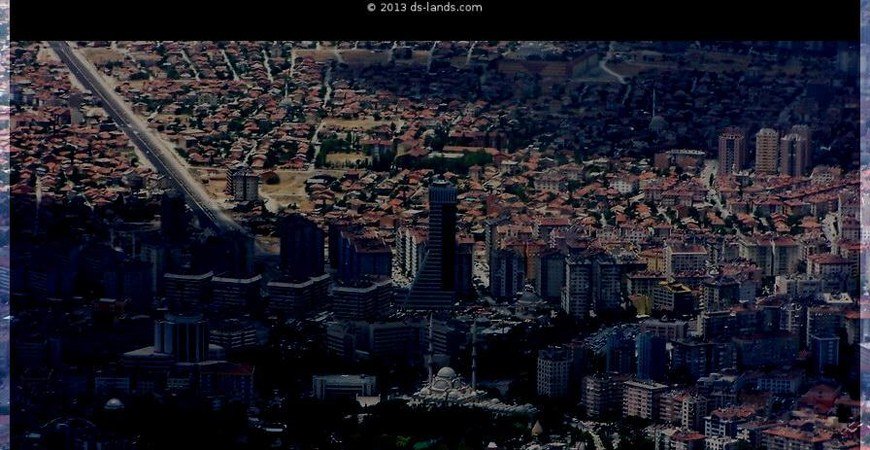
The Museums of Konya Turkey – Chapter 2
The Museums of Konya Turkey – Chapter 2,
Konya Grave Museum:
The Konya Grave Museum was opened in 1960 in the Sircali Medrese in Konya, which was built during the Seljuk period by Bedreddin Muslih in 1242. It has a courtyard decorated with tiles. The museum contains gravestones of historical and artistic value taken from graveyards in Konya and classified into three periods – Seljuk, Beylik and Ottoman. The gravestones are arranged both in chronological order and according to style design and style of writing on them.
Konya Regional Ethnographic Museum:
A new museum building between 1971 and 1974 on Sahip-Ata Boulevard in Konya houses the Konya Regional Ethnographic Museum. The ground floor of the museum is a depot. The large room on the first floor contains Konya costumes, Konya handicrafts, jewellery, coffee, tobacco and writing sets, copper kitchen utensils, candlesticks, and other ethnographic objects from the Konya region. The small room contains weapons from the Ottoman period and a collection of coins. The top floor of the museum consists of administrative offices.
Koyunoglu Museum:
A. Izzet Koyunoglu of Konya donated a rich collection of ethnographic objects which he had collected over a period of 62 years from 1913 until his death in 1975 to Konya Municipality on the condition that they are exhibited in a museum established in his own house in his name.
Konya Municipality stored the collection and began work on establishing the museum.
The Koyunoglu Museum collection includes gilded books illustrated with miniatures, carpets and cloth, articles of clothing, embroidery, drawers inlaid with mother of pearl and ivory, lecterns and chairs, objects made of gold, silver, bronze, copper and iron, ceramics and tiles, inscriptions by famous calligraphers, oil paintings and glass etc.
Konya Eregli Museum:
The historical wealth and touristic potential of Eregli, a sub-province of Konya, in mind, construction of a museum building was begun and the museum opened to the public in 1967. As well as objects from Eregli and its surrounding area there are also works brought from Istanbul and Ankara. Eregli Museum consists of an entrance hall, a large exhibition room, two offices etc.
The exhibition room contains archaeological works from the region of Eregli, including bowls, pots, stones, inscriptions, statues, figurines etc., Roman, ‘Byzantine and Islamic money, manuscript Korans, tablets and lecterns, ethnographic objects from Eregli such as women’s clothes, jewellery, wooden objects etc. The museum also has a depot.
Karaman Museum:
Karaman Museum was first housed in a temporary building in 1959, and archaeological and ethnographic works from the region of Karaman were stored here. A new building was constructed south of the Hatuniye Medrese and upon completion, the works were exhibited here. Karaman Museum is an interesting local museum containing various archaeological works from the earliest ages to the Roman and Byzantine periods, works from the Karamanogullari and Ottoman periods, and ethnographic works.
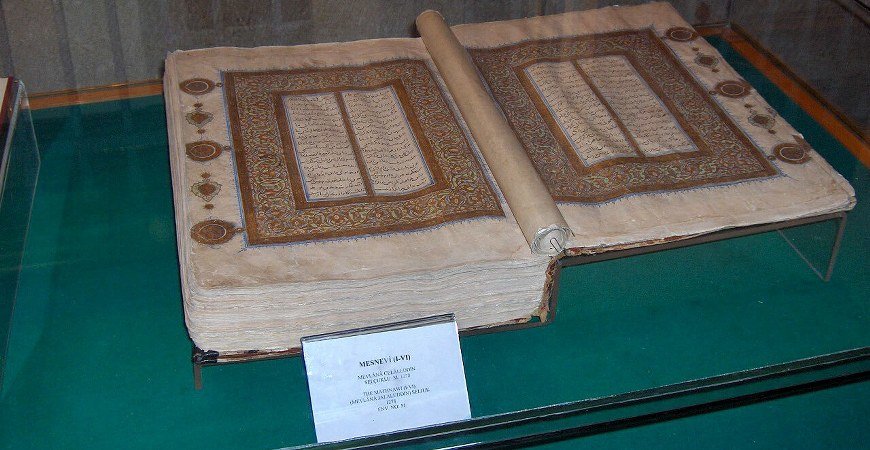
The Museums of Konya Turkey – Chapter 1
The Museums of Konya Turkey – Chapter 1,
Konya Archaeological Museum:
Archaeological finds from Konya and its surrounding region are exhibited in the Archaeological Museum which is situated to the west of the Sahipata Kulliye in Konya. In 1963 the museum moved to a new building and the objects are exhibited in the following pavilions:
1 — Pavillion of Gravestones, Sarcophagi and inscriptions : There are grave steles, sacrificial altars, and statues of lions and people from the Roman period (I-IV Centuries AD); masonry, sarcophagi, and inscriptions from the classic period; and stone objects from the Byzantine period exhibited in the museum garden and the colonnades opening onto the garden. Their place of origin is generally not known. You enter the enclosed rooms of the museum through the garden.
2 — Pavillion of the Classic Period : In this pavilion are inscriptions, statues, building stones, sarcophagi, clay, metal and glass objects etc. found in the region of Lycaonia, Konya (lconium), Bozkir (Isauria), Yalvac (Antiochian), Aksehir (Philomeleum), Eregli (Heraclea). Amber Koyu
(Sidamara), Karaman (Luanda), Ladik (Laodikeia), Hatunsaray (Lystra), and Yunuslar. Among the most important of the exhibits is a marble Roman sarcophagus decorated with bas-reliefs depicting the Twelve Labors of Hercules, which dates from the III century AD and was found in 1958 near to Yunuslar Village.
3 — Excavation Finds: In the other rooms and showcases of the museum are various clay objects, pottery, stone objects and seals, statuettes, ornaments etc. dating from the Prehistoric age and the Hittites and Phrygian periods, found at Catalhoyuk, Can Hasan, Sigma, and Karahoyuk. Konya Archaeological Museum is important for the light it throws on the pre-Seljuk periods and the art and culture of the pre-Islamic periods in Konya and the surrounding region.
Museum of Seljuk Period Stone and Wood Carving:
The Inceminare Hadis built during the Seljuk period was repaired in 1956 and turned into the Museum of Seljuk Period Stone and Wood Carving. The Inceminate Hadis was built in 1267 by the Seljuk Grand Vizier Sahip-Ata Fahreddin Ali and designed by the architect Keluk son of Abdullah. The Dar’61 Hadis has a magnificent stone portal and a brick minaret decorated with tiles, of which the part above the first balcony has been destroyed. The rooms which had been demolished were restored in recent years. In the courtyard of Inceminate are fine examples of gravestones, inscriptions, and building stones from the Seljuk and Karamanogullari periods found in Konya. In the rooms of the museum are figurative stone decorations from Konya Castle. built by the Seljuk Sultan Alaeddin Keykubad I in 1221. Among the most interesting of these are bas-reliefs depicting a two-headed eagle, a winged angel, a dragon, a harpy, a fish, an elephant and rhinoceros, lions and people. In the showcases are representational, patterned and inscribed stucco reliefs from the interior decorations of the Konya Seljuk House.
Exhibited in the exedra of Inceminare are windows and doors, lecterns etc. taken from Seljuk and Beylik period buildings in Konya, Ottoman period chests of drawers, and other wooden works of art. Of particular interest are the doors and windows from the Beyhekim Mescid (XIII century).
You can continue to find more museums and details on The Museums of Konya Turkey in Chapter 2.
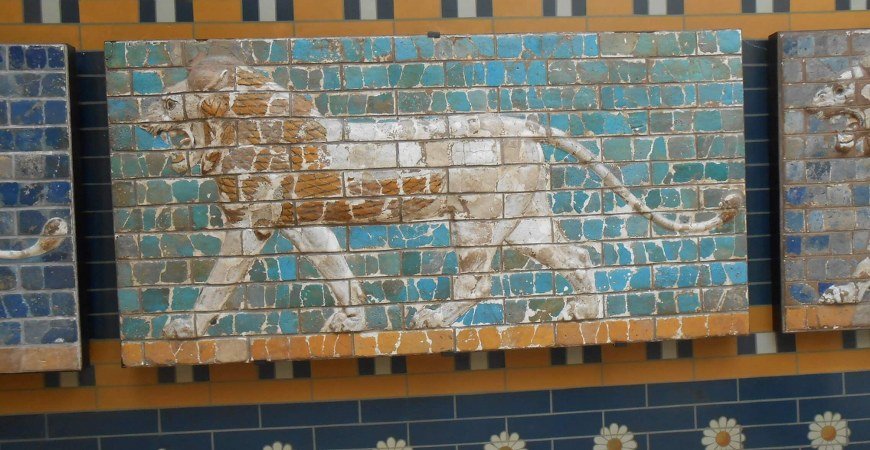
Ancient Oriental Works of the Istanbul Archaeological Museum – Chapter 2
Ancient Oriental Works of the Istanbul Archaeological Museum – Chapter 2,
Today Turkish experts can both discover and read these tablets. There are extremely interesting examples of tablets among those in the Istanbul Archaeological Museum. For example the tablet of the famous Kades Treaty of 1269 BC between the Hittite King Hatusilis II and the Egyptian Pharaoh Rameses II, according to which both states were to live in friendship and defend one another against enemies. Political criminals escaping from either country were to be deported back. As the first written record of a political treaty between states, the Kades Treaty tablet was exhibited in the United Nations building in New York a few years ago. Commercial agreements are also valuable records. Most of these are letters sent by Assyrian traders to Anatolian traders. From these tablets, it has ‘been learned what ores were mined, what food was eaten and what clothes worn, the cloth which was woven, what weapons were used, the life of the people and the economic situation. A tablet found in Kultepe which was sent to Kanis from Assyria 4 thousand years ago mentions a case of smuggling through customs. This is perhaps the earliest known case of smuggling. The Assyrian trade, after telling his friend that the smuggled goods were discovered at the border and the matter being followed up, said to his friend: If anyone ever asks you to give them your tin and cloth and promises to smuggle them for you, beware not to listen, because they are all accomplices there”. Another tablet is a moving love letter, in which the lover asks why his loved one has left him all alone. In another letter, the writer says to his loved one “I love you like hot olive oil’. And on another, in the form of a poem, is written: “My precious caresses are sweeter than honey. Come to my bridegroom and let me caress you” These words are probably the first passions poured out in cuneiform by a fiery lover. These few examples will have to suffice here… Yes… There is a historical treasure house that most of us are unaware of in Istanbul Archaeological Museum. The world’s first written documents. They’re worth.cannot be measured in millions. The voices of the first writers, using a language that today only experts can understand, who brought civilization to the world and are only now letting the world know their names and fame, who established a stable legal and commercial system, who longed to live in peace, who loved and were loved.

Ancient Oriental Works of the Istanbul Archaeological Museum – Chapter 1
Ancient Oriental Works of the Istanbul Archaeological Museum – Chapter 1,
The section of Ancient Oriental Works of the Istanbul Archaeological Museum contains one of the world’s richest historical -archives in existence today, the Cuneiform Documents. These were written on soft clay, and then either dried in the sun or baked in special ovens and include 4010-year-old letters, edicts, title deeds, agreements, in short, they are written records of the political, economic and social life of an age. If it were not for this history could not have been written. We would have been left in the dark about the Sumerians, the Hittites, and the Assyrians. These clay tablets have informed us about the past, they have spread it in front of us in all its facets. Istanbul Archaeological Museum contains 74 thousand clay tablets written in cuneiform. Have all of these being read? According to museum officials, most of them have been studied and an inventory prepared, but there are still many that have not been read or studied. If you are curious about the source of such a large number of tablets, here is the answer. Before the First World War, the region of Mesopotamia in Iraq where several ancient civilizations sprang up was part of the Ottoman Empire. Founder of Istanbul Archaeological Museum Osman Hamdi Bey was Director of Museums. Just as he had a law passed making all ancient works the property of the state, so Hamdi Bey was organizing archaeological excavations in territories under the sovereignty of the Ottoman State. Most of these tablets were found in excavations in Mesopotamia and brought to Istanbul. There are also valuable documents left from the Babylonian library. The rest of the tablets were found in Anatolia. A significant number of cuneiform tablets were found at the site of the former Hittite capital, Hattusas (now called Bogazkoy) and at the center of the Anatolian trade colonies of the Assyrians, Kanis (near Kayseri and now called Kultepe). Finding them is easy but who is going to read them. Foreign experts you may say. The first person to consider this serious problem was Ataturk. He established the Faculty of Language and History in Ankara in order to train experts in the Hittite, Sumerian and Akad languages, and he also had students sent to Europe and America.
You can continue to find more about Ancient Oriental Works of the Istanbul Archaeological Museum in Chapter 2.
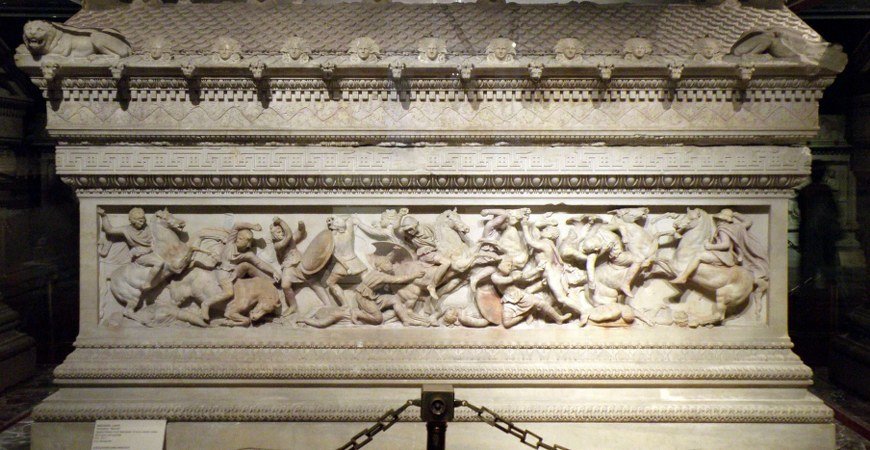
The Alexander Sarcophagus in Archaeological Museum of Istanbul
The Alexander Sarcophagus in Archaeological Museum of Istanbul,
One of the world’s unparalleled masterpieces is the Alexander Sarcophagus which has been on exhibit in Istanbul Archaeological Museum for 87 years. It is to Istanbul Archaeological Museum what the Mona Lisa is to the Louvre or the decorated Sarcophagus of Cleopatra to the British Museum.
The discovery of this masterpiece of art which was made at the beginning of the fourth century BC is an interesting story: The well-known painter and scholar Osman Hamdi Bey was appointed as Director of Istanbul Archaeological Museum. He first oorganizedTurkish museum studies by having an Antiquities Act passed which made it illegal for antiquities to be smuggled out of the country. After that, he carried out archaeological excavations in previously unknown historical centers in the Ottoman Empire. He uncovered large statues dating from the Komagene Kingdom during excavations at Emerald Mountain near Adiyaman for example. In 1887 he received news that there were certain works of antiquity buried near Sayda, which is today part of the Lebanon. A farmer called Serif in Sayda had come across a grave room while he was plowing his field. When the soil had been removed from over the door of the room he saw that it contained several marble sarcophagi and he notified the authorities, who sent a telegraph to Istanbul. Upon hearing the news Osman Hamdi Bey left for Sayda and began excavating. The site turned out to be an underground necropolis of the Phrygian Kings. Within a few months, more than twenty stone and marble sarcophagi were removed from the grave rooms, among them those of Alexander and the Weeping Women.
Now the sarcophagi were above ground but the problem did not end there. To transport these works, weighing tons, to Istanbul without damage was a still greater problem. No ship would take the responsibility of carrying these works which were as heavy as they were valuable. However in the end agreement was reached with a cargo ship. As the Alexander Sarcophagus was winched onto the ship Osman Hamdi Bey tied himself to the sarcophagus too to prevent any harm coming to it.
The sarcophagi got to Istanbul safe and sound and were exhibited in the museum, where all of Istanbul came rushing to see them. Taking advantage of this widespread interest Osman Hamdi Bey proposed to the Ottoman Sultan that a modern museum building is constructed. The Sultan agreed and in 1891 this new building, which houses the Archaeological Museum today, was completed, and the sarcophagi placed in this museum.
The Alexander Sarcophagus is in the form of a temple, constructed of marble and 2.12 m. high, 3.18 m. long and 1.67 m. wide. .0n its two long sides are bas-reliefs depicting Alexander’s wars with the Persians, which is the reason why it was named the Alexander Sarcophagus. Experts say that it is not actually that of Alexander.
As you know the Macedonian King Alexandra the Great became ill while on the shore of the Indus river and went back to his palace in Babylon. He died in Babylon on June 13, 323 BC. His body was taken to Alexandria in Egypt and there buried. However, the Alexander Sarcophagus was constructed in the fourth century either during his lifetime or just after his death.
One of the long sides of the sarcophagus depicts Alexandra on a rearing horse, with a lion skin on his shoulders. He has a lance in his hand and is preparing to throw it at one of the Persian cavalries. The other long side depicts Alexander as a young warrior carrying the symbol of kingship. All four faces of the sarcophagus are filled with a mythological depiction of Alexander’s bloody battles with the Persian army. The pointed roof of the sarcophagus is also decorated with bas-reliefs which were originally painted, but the paint has worn off except for a few scattered traces. Various stories are told about the Alexander Sarcophagi. For example, it’s said that when the German Emperor Wilhelm II visited Istanbul he asked the sultan for this sarcophagus. When the St Ran asked Osman Hamdi Bey what the thought of this idea, Osman Hamdi Bey was outraged:
This sarcophagus is worth a nation in itself, he replied. I do not suppose that my Sultan wishes to present one of his nations to an emperor. If such a thing happens decree that it should be dragged away over my body. This reply ensured that the sarcophagus stayed in its place.

Four Seljuk Lecterns and Museum of Turkish & Islamic Art
Four Seljuk Lecterns and Museum of Turkish & Islamic Art,
Although the Museum of Turkish and Islamic Art ‘which was established in the Suleymaniye Imaret in 1914 contains a rich collection of Turkish works of art, it is not visited as much or so well known as Topkapi Palace. Yet this museum contains not only Ottoman period works but also works dating from the Seljuk and Beylik periods in Anatolia. Thus it presents a complete cross section of Anatolian Turkish culture. Here you can see the finest examples of Seljuk tiles, prize examples of carved wooden works, the oldest carpets and gilded manuscripts from the Seljuk period. Among these works is a carved wooden Seljuk period lectern, whose equal is in the Pergamon Museum in East Berlin. Two similar to it is in Konya Mevlana Museum.
Only four Seljuk period lecterns remain to us after 250 years of Seljuk rule. There were probably others which did not survive to enter museums.
These lecterns which were used for reading the Koran or other books had two feet and opened and shut. A person sitting cross-legged would open the lectern and place his book on it. They were used not only in mosques but also in schools and homes. They prevented the book from. being opened while horizontal thus saving it from damage. During the Seljuk period, they were usually made of ‘walnut or ebony wood and their surfaces decorated with carvings and inlaid designs. Later on, these lecterns were inlaid with ivory, mother of pearl, gold, and silver.
The First Lectern is in the Istanbul Museum of Turkish and Islamic Art. In 1911 it Was brought from the Tomb of the Seljuk sultans in Konya to the Trust Museum in Istanbul which was newly being established at that time, and at first displayed in the Tiled Pavillion. The Sulus script writing in relief on the lectern records that it ‘was made for the Seljuk Sultan Izzeddin Keykavus the Second around 1258. The lectern is decorated with carved Seljuk motifs.
The Second Lectern is in Konya Mevlana Museum. According to the writing in relief upon it was presented to the Mevlana Tomb in 1279 by Cemaleddin Mubarak a close friend of the Seljuk Grand Vizier of the time Sahip Ata Fahreddin Ali. Mubarak, who also donated the gilded Mesnevi which is among the masterpieces in the Konya Mevlana Museum, had this lectern made by the greatest masters of the time and presented it to the Tombs of Mevlana 6 years after Mevlana’s death. The lectern is made of walnut and is 95 cm. high and 43 cm. wide. Its outer surfaces are decorated with raised Seljuk motifs while its inner surfaces are decorated with lacquered gilding and colored designs, and a panel on which is depicted a two-headed eagle, the coat of arms of the Seljuk sultans, surrounded by lions.
The Third Seljuk Lectern is also in Konya Mevlana. Museum. This resembles the second and carved on it are words of the Prophet. One of the sentences reads “The sins of those who love scientists and scholars cannot be written while they still live”. The Fourth Lectern is in the section of Turkish and Islamic Art in the Pergamon Museum in East Berlin. According to the museum records this lectern was taken from the Alaeddin Mosque and brought to Berlin in 1907. It is a metre in height and 50 cm. wide and carved out of walnut wood. It is decorated with writing and Seljuk motifs. The Cufic and Sulus inscriptions are verses from the Koran. These four lecterns are masterpieces of the art of woodwork in the Anatolian Seljuk period. They have been exhibited, both together and separately in several countries of the world, including America, France and Germany. Lecterns made later in the Beylik and Ottoman periods, which are now in museums of mosques may not be able to equal the craftsmanship of these lecterns, but there are still many among them of great artistic value. Particularly the Ottoman lecterns in the Istanbul Museum of Turkish and Islamic Art and Topkapi Palace cannot be denied the right to be called masterpieces. And as well as the lecterns the Seljuk pulpits, platforms, sarcophagi and lattices should not be forgotten when compiling a list of the masterpieces of the Turkish art of wood carving.
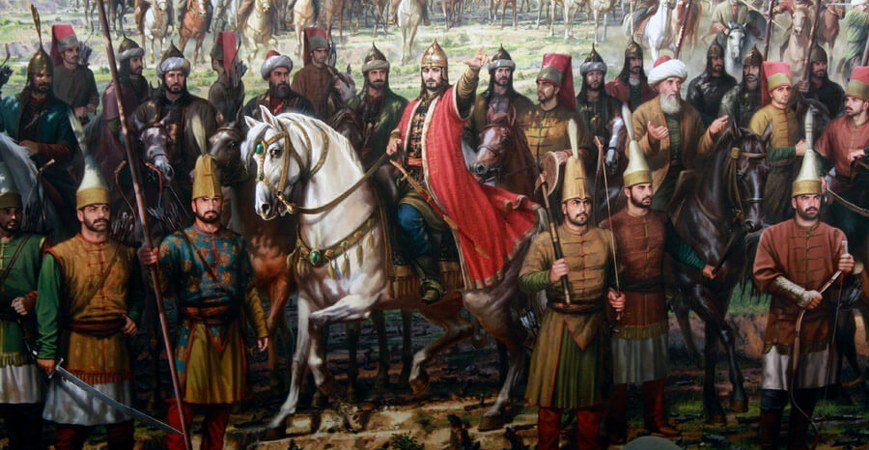
Istanbul Topkapi Palace and The Fatih Sultan Mehmed’s Caftan
The Fatih Sultan Mehmed’s Caftan in Istanbul Topkapi Palace,
In the spring of 1481 Sultan Mehmed, the Conqueror was making preparations for a new campaign. The campaign symbol, the sultan’s tenants, had been set on Uskudar. Although the destination was not made public, it was obvious that it was somewhere in Asia from the fact that the army had gathered on the Anatolian side of the Bosphorus. On April 27 the Conqueror crossed to Uskudar. His face was pale and his actions languid. It was known that he had suffered from pain in his joints for a considerable time. He rested in Uskudar for several days, then got in a carriage and gave the order to his soldiers to set off. When the convoy arrived near Gebze at the Tekfur meadows, his condition considerably worsened. The doctors drew some blood and pronounced that it was inadvisable for the sultan to continue on his journey. The sultan’s tent was set up, and the Conqueror retired to it. His temperature rose, and medicines and sherbets did nothing to improve his condition. On Thursday, May 5, towards noon, this great statesman took his last breath. It was essential to hide his death from the soldiers. His body was dressed and placed in a closed carriage. It was announced that the Sultan would spend a few days bathing in Istanbul before the journey was continued. Even in spite of this secrecy, however, the news of his death leaked out and a section of the janissaries returned to Istanbul. However, without any great confusion or feeding the prince Beyazid who at that time was governor of Amasya managed to get to Istanbul within 9 days and take over his father’s throne. At the time of his death, the Conqueror was wearing an indigo blue caftan made of Bursa silk. This caftan was cut from his body and today is exhibited in the section containing clothing of the sultans in Topkapi Palace Museum. Of significance as the last piece of clothing worn by the Sultan, it was filled with fine cotton and lined with a fine beige colored cloth. There are twelve buttons down the front of the caftan. Apart from this caftan, there are also underclothing, other captains, iron armor, the helmet and the emerald aigrette of the Conqueror. Among his caftans is one made of gold worked brocade, of which both the style and cloth itself are beautiful. The caftan is decorated with intertwined insignias of Sultan Suleyman, tulips, carnations and roses among four large clouds. Another caftan of the sultan is made of silk brocade from Bursa upon which is worked a star pattern containing tulips and pomegranate flowers, surrounded by a design of clouds. The sleeves of the caftan are short, the front is worked with silver thread and it is double breasted. From measurements taken from these caftans the measurements of the Conqueror have been worked out, showing him to have been 1.70 m. in height, slim and well proportioned. During the time of the Conqueror, Turkish textiles were much advanced. Particularly the Bursa silk of this period had no equal. The velvet brocades, gold and silver thread worked brocades, cloth of gold called ‘seraser’ and ‘zerbaft’, fine silks and satins were sent to the four corners of the state, and the richest clothing made from them. Apart from Bursa, the checked cloth of Denizli, the alpaca of Ankara, the fine cotton of Manisa and the woolen cloth made in Diyarbakir were also famous. In the palace was a special tailor’s shop where the clothes for the sultan were made. The tailors would be told the sultan’s measurements and sew clothes for him. The Chief Agha was in charge of the sultan’s clothes, and the Tulbend Agha in charge of the sultan’s underclothes and turbans. Sultan Mehmed the Conqueror used to wind his turban in the style of scholars like his grandfather Chelebi Sultan Mehmed. Usually, he wore furs with collars over his caftans. During the days of the conquest of Istanbul, the Conqueror did not remove his caftan for 53 days because night and day he was at the head of the army. Today in Topkapi Palace you can see all sizes of clothes belonging to every sultan from Osman Gazi to the last Ottoman sultan. Each one, besides being a historical souvenir of the Sultans is also the finest examples of Turkish textiles of each period. But all eyes are drawn to the caftans of the Conqueror. His gold worked caftans were in keeping with the greatness of the Ottoman Sultan Mehmed II, Conqueror of Istanbul.
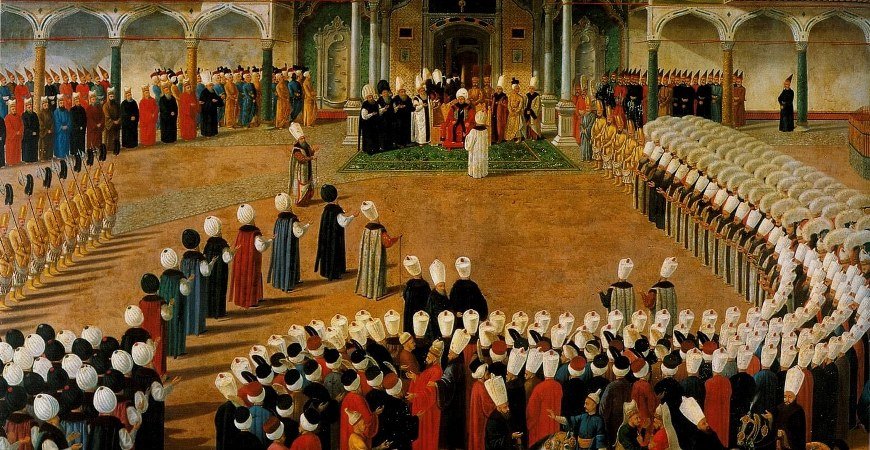
The Festival Throne In Topkapi Palace Istanbul – Chapter 2
The Festival Throne In Topkapi Palace Istanbul – Chapter 2,
The military band would take their place and begin to play. Then the princes would come wearing shining new clothes and take their places to the left of the throne before the sultan had sat down. Behind them would be halberdiers and heartaches. The janissarie agha, the keeper of the hounds and the other aghas would take their places to the right of the throne. Important men of state and palace officials would take their places in front of the throne. After morning prayers the sultan would arrive with a procession and greeting those assembled take his place on the throne. At his entrance everyone would call out “My sultan, may you live long” and the sound of prayers being said would be clamorous. As the sultan sat on the throne, first the Sadrazam, followed by the viziers, Sheik ullslam, vice chancellor, chief minister of finance would greet the sultan. In this ceremony only the Sheik uldslam did not have to kiss the sultan’s robe but only bow slightly. The Sadrazam would read out the names of all the men of state, scholars, theologians etc. who were attending the ceremony, from a notebook and introduce them to the sultan. As previously instructed they would kiss either the sultan’s robe or the fringe of the throne as their names were read out. After the ceremony was over the sultan would rise to his feet with the sadrazam on his right and the harem agha on his left and once more greeting those assembled would go to the holiday prayers in procession, After the ceremony the palace chief treasurer would take the Festival Throne back to the treasury. It is not known for certain when and by whom the Festival Throne was made. Historians write that this throne, made of 400 kilos of gold and decorated with precious stones, was a present to Sultan Murad the Third by Ibrahim Pasha. Those who have investigated this claim say that it is not the same throne. It is thought that it was made in the first half of the Eighteenth Century. In an archive document in the palace dated 1760 it talks about an “imperial throne” covered with gold and decorated with 953 topazes, among the objects in the treasury. This can be no other than the Festival Throne itself, which has 954 topaz on it, one more than recorded. The throne is covered with plates of gold, the back being decorated with gold thread and rose patterned cloth. There are portraits of Mustafa the Third, Selim the Third and Mustafa the Fourth seated on this throne, ex-hibited in the Portrait Gallery in Topkapi Palace today. The Festival Throne is one of the masterpieces among the riches and souvenirs of a huge state which lasted for 600 years, in Topkapi Palace. Turkish and foreign visitors to the museum always return for a second look at this throne of such beauty and fineness.

The Festival Throne In Topkapi Palace – Chapter 1
The Festival Throne In Topkapi Palace – Chapter 1,
Visitors to the Treasury of Topkapi Palace Museum will see a gold throne shaped like an armchair and big enough to easily fit two people, placed in a case in the center of the fourth room. This throne, called the Festival Throne, is decorated with topazes and is of as great material as historical value. It recalls a very important palace ceremony of the past. One of the large ceremonies which were held in Ottoman Palaces were the Celebration ceremonies held on festivals days, at which the sultan would celebrate religious festivals with the important men of the state. These traditional ceremonies were planned down to the smallest detail, the formalities which regulated them even being recorded in the statute beck. With a few small changes, these ceremonies continued to be held right up to the final days of the Ottoman state. According to historians, it was Sultan Mehmed the Conqueror who first laid down set regulations and procedures for holding these Celebration ceremonies. One clause in the Ottoman Law Code which the Conqueror had written is as follows: “It is my order that on festival days a throne should be set up in the council square. Then the viziers, vice chancellors and minister of finance shall kiss my hand. My law lays down that I will stand before my viziers, my vice chancellors and my chief minister of finance”. The Conqueror described the Celebration ceremonies down to the finest detail in his own statute book, even stating who should stand and who not. Although certain changes were made the ceremonies were basically as follows: Early on the morning of the festival before the holiday prayers, the sultan’s Festival Throne would be taken from the treasury and placed in the hall in front of the Bab’us-Saade gate leading into the third courtyard. Silk carpets would be spread on the floor and the Throne placed on top of these carpets. All the lights in the palace would be lit and torches would illuminate the area around the throne.
You can continue to find more details about The Festival Throne In Topkapi Palace in Chapter 2.